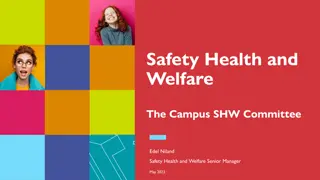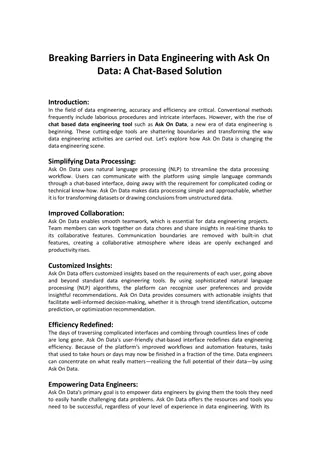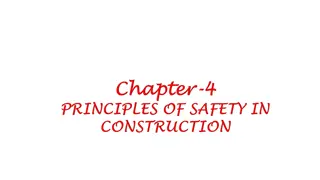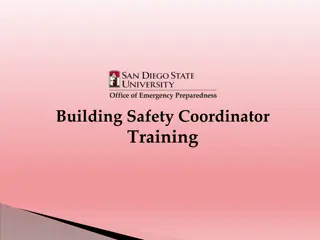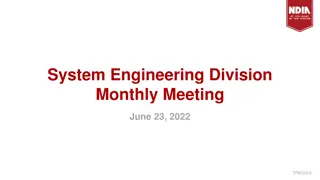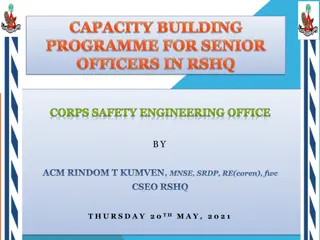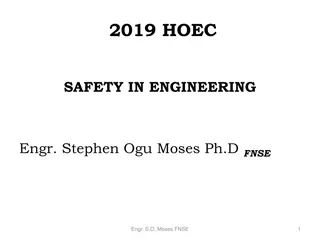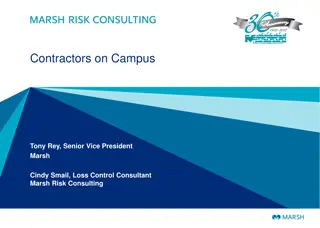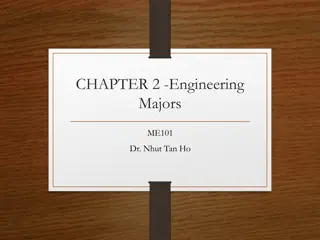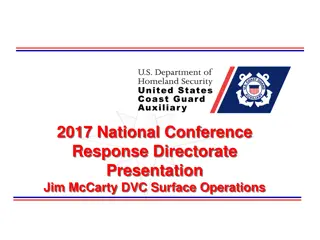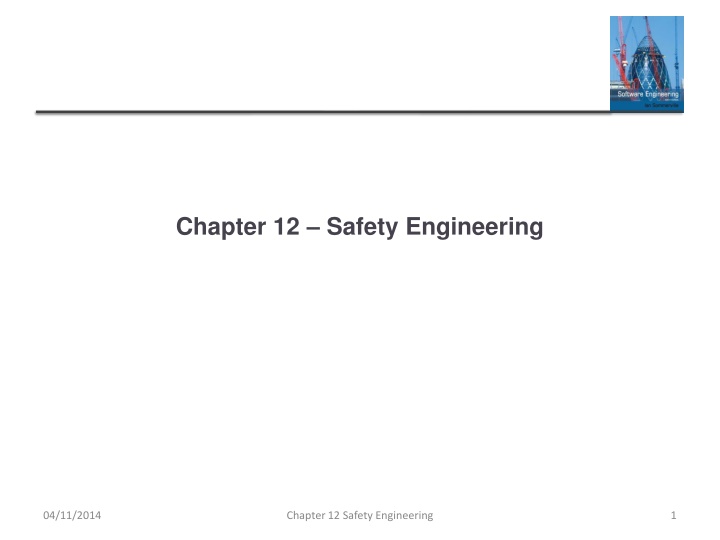
Importance of Safety Engineering in Critical Systems
Explore the significance of safety engineering in critical systems, understanding the relationship between safety, reliability, and software in ensuring system integrity and human protection. Learn about the risks posed by unsafe reliable systems and the essential role of software in monitoring safety-critical components.
Download Presentation

Please find below an Image/Link to download the presentation.
The content on the website is provided AS IS for your information and personal use only. It may not be sold, licensed, or shared on other websites without obtaining consent from the author. If you encounter any issues during the download, it is possible that the publisher has removed the file from their server.
You are allowed to download the files provided on this website for personal or commercial use, subject to the condition that they are used lawfully. All files are the property of their respective owners.
The content on the website is provided AS IS for your information and personal use only. It may not be sold, licensed, or shared on other websites without obtaining consent from the author.
E N D
Presentation Transcript
Chapter 12 Safety Engineering 04/11/2014 Chapter 12 Safety Engineering 1
Topics covered Safety-critical systems Safety requirements Safety engineering processes Safety cases 04/11/2014 Chapter 12 Safety Engineering 2
Safety Safety is a property of a system that reflects the system s ability to operate, normally or abnormally, without danger of causing human injury or death and without damage to the system s environment. It is important to consider software safety as most devices whose failure is critical now incorporate software-based control systems. 04/11/2014 Chapter 12 Safety Engineering 3
Software in safety-critical systems The system may be software-controlled so that the decisions made by the software and subsequent actions are safety-critical. Therefore, the software behaviour is directly related to the overall safety of the system. Software is extensively used for checking and monitoring other safety-critical components in a system. For example, all aircraft engine components are monitored by software looking for early indications of component failure. This software is safety-critical because, if it fails, other components may fail and cause an accident. 04/11/2014 Chapter 12 Safety Engineering 4
Safety and reliability Safety and reliability are related but distinct In general, reliability and availability are necessary but not sufficient conditions for system safety Reliability is concerned with conformance to a given specification and delivery of service Safety is concerned with ensuring system cannot cause damage irrespective of whether or not it conforms to its specification. System reliability is essential for safety but is not enough Reliable systems can be unsafe 04/11/2014 Chapter 12 Safety Engineering 5
Unsafe reliable systems There may be dormant faults in a system that are undetected for many years and only rarely arise. Specification errors If the system specification is incorrect then the system can behave as specified but still cause an accident. Hardware failures generating spurious inputs Hard to anticipate in the specification. Context-sensitive commands i.e. issuing the right command at the wrong time Often the result of operator error. 04/11/2014 Chapter 12 Safety Engineering 6
Safety-critical systems 04/11/2014 Chapter 12 Safety Engineering 7
Safety critical systems Systems where it is essential that system operation is always safe i.e. the system should never cause damage to people or the system s environment Examples Control and monitoring systems in aircraft Process control systems in chemical manufacture Automobile control systems such as braking and engine management systems 04/11/2014 Chapter 12 Safety Engineering 8
Safety criticality Primary safety-critical systems Embedded software systems whose failure can cause the associated hardware to fail and directly threaten people. Example is the insulin pump control system. Secondary safety-critical systems Systems whose failure results in faults in other (socio-technical) systems, which can then have safety consequences. For example, the Mentcare system is safety-critical as failure may lead to inappropriate treatment being prescribed. Infrastructure control systems are also secondary safety-critical systems. 04/11/2014 Chapter 12 Safety Engineering 9
Hazards Situations or events that can lead to an accident Stuck valve in reactor control system Incorrect computation by software in navigation system Failure to detect possible allergy in medication prescribing system Hazards do not inevitably result in accidents accident prevention actions can be taken. 04/11/2014 Chapter 12 Safety Engineering 10
Safety achievement Hazard avoidance The system is designed so that some classes of hazard simply cannot arise. Hazard detection and removal The system is designed so that hazards are detected and removed before they result in an accident. Damage limitation The system includes protection features that minimise the damage that may result from an accident. 04/11/2014 Chapter 12 Safety Engineering 11
Safety terminology Term Definition Accident (or mishap) An unplanned event or sequence of events which results in human death or injury, damage to property, or to the environment. An overdose of insulin is an example of an accident. Hazard A condition with the potential for causing or contributing to an accident. A failure of the sensor that measures blood glucose is an example of a hazard. Damage A measure of the loss resulting from a mishap. Damage can range from many people being killed as a result of an accident to minor injury or property damage. Damage resulting from an overdose of insulin could be serious injury or the death of the user of the insulin pump. Hazard severity An assessment of the worst possible damage that could result from a particular hazard. Hazard severity can range from catastrophic, where many people are killed, to minor, where only minor damage results. When an individual death is a possibility, a reasonable assessment of hazard severity is veryhigh . Hazard probability The probability of the events occurring which create a hazard. Probability values tend to be arbitrary but range from probable (say 1/100 chance of a hazard occurring) to implausible (no conceivable situations are likely in which the hazard could occur). The probability of a sensor failure in the insulin pump that results in an overdose is probably low. Risk This is a measure of the probability that the system will cause an accident. The risk is assessed by considering the hazard probability, the hazard severity, and the probability that the hazard will lead to an accident. The risk of an insulin overdose is probably medium to low. 04/11/2014 Chapter 12 Safety Engineering 12
Normal accidents Accidents in complex systems rarely have a single cause as these systems are designed to be resilient to a single point of failure Designing systems so that a single point of failure does not cause an accident is a fundamental principle of safe systems design. Almost all accidents are a result of combinations of malfunctions rather than single failures. It is probably the case that anticipating all problem combinations, especially, in software controlled systems is impossible so achieving complete safety is impossible. Accidents are inevitable. 04/11/2014 Chapter 12 Safety Engineering 13
Software safety benefits Although software failures can be safety-critical, the use of software control systems contributes to increased system safety Software monitoring and control allows a wider range of conditions to be monitored and controlled than is possible using electro-mechanical safety systems. Software control allows safety strategies to be adopted that reduce the amount of time people spend in hazardous environments. Software can detect and correct safety-critical operator errors. 04/11/2014 Chapter 12 Safety Engineering 14
Safety requirements 04/11/2014 Chapter 12 Safety Engineering 15
Safety specification The goal of safety requirements engineering is to identify protection requirements that ensure that system failures do not cause injury or death or environmental damage. Safety requirements may be shall not requirements i.e. they define situations and events that should never occur. Functional safety requirements define: Checking and recovery features that should be included in a system Features that provide protection against system failures and external attacks 04/11/2014 Chapter 12 Safety Engineering 16
Hazard-driven analysis Hazard identification Hazard assessment Hazard analysis Safety requirements specification 04/11/2014 Chapter 12 Safety Engineering 17
Hazard identification Identify the hazards that may threaten the system. Hazard identification may be based on different types of hazard: Physical hazards Electrical hazards Biological hazards Service failure hazards Etc. 04/11/2014 Chapter 12 Safety Engineering 18
Insulin pump risks Insulin overdose (service failure). Insulin underdose (service failure). Power failure due to exhausted battery (electrical). Electrical interference with other medical equipment (electrical). Poor sensor and actuator contact (physical). Parts of machine break off in body (physical). Infection caused by introduction of machine (biological). Allergic reaction to materials or insulin (biological). 04/11/2014 Chapter 12 Safety Engineering 19
Hazard assessment The process is concerned with understanding the likelihood that a risk will arise and the potential consequences if an accident or incident should occur. Risks may be categorised as: Intolerable. Must never arise or result in an accident As low as reasonably practical(ALARP). Must minimise the possibility of risk given cost and schedule constraints Acceptable. The consequences of the risk are acceptable and no extra costs should be incurred to reduce hazard probability 04/11/2014 Chapter 12 Safety Engineering 20
The risk triangle 04/11/2014 Chapter 12 Safety Engineering 21
Social acceptability of risk The acceptability of a risk is determined by human, social and political considerations. In most societies, the boundaries between the regions are pushed upwards with time i.e. society is less willing to accept risk For example, the costs of cleaning up pollution may be less than the costs of preventing it but this may not be socially acceptable. Risk assessment is subjective Risks are identified as probable, unlikely, etc. This depends on who is making the assessment. 04/11/2014 Chapter 12 Safety Engineering 22
Hazard assessment Estimate the risk probability and the risk severity. It is not normally possible to do this precisely so relative values are used such as unlikely , rare , very high , etc. The aim must be to exclude risks that are likely to arise or that have high severity. 04/11/2014 Chapter 12 Safety Engineering 23
Risk classification for the insulin pump Identified hazard Hazard probability Accident severity Estimated risk Acceptability 1.Insulin overdose computation Medium High High Intolerable 2. Insulin underdose computation Medium Low Low Acceptable 3. Failure of hardware monitoring system Medium Medium Low ALARP 4. Power failure High Low Low Acceptable 5. Machine incorrectly fitted High High High Intolerable 6. Machine breaks in patient Low High Medium ALARP 7. Machine causes infection Medium Medium Medium ALARP 8. Electrical interference Low High Medium ALARP 9. Allergic reaction Low Low Low Acceptable 04/11/2014 Chapter 12 Safety Engineering 24
Hazard analysis Concerned with discovering the root causes of risks in a particular system. Techniques have been mostly derived from safety-critical systems and can be Inductive, bottom-up techniques. Start with a proposed system failure and assess the hazards that could arise from that failure; Deductive, top-down techniques. Start with a hazard and deduce what the causes of this could be. 04/11/2014 Chapter 12 Safety Engineering 25
Fault-tree analysis A deductive top-down technique. Put the risk or hazard at the root of the tree and identify the system states that could lead to that hazard. Where appropriate, link these with and or or conditions. A goal should be to minimise the number of single causes of system failure. 04/11/2014 Chapter 12 Safety Engineering 26
An example of a software fault tree 04/11/2014 Chapter 12 Safety Engineering 27
Fault tree analysis Three possible conditions that can lead to delivery of incorrect dose of insulin Incorrect measurement of blood sugar level Failure of delivery system Dose delivered at wrong time By analysis of the fault tree, root causes of these hazards related to software are: Algorithm error Arithmetic error 04/11/2014 Chapter 12 Safety Engineering 28
Risk reduction The aim of this process is to identify dependability requirements that specify how the risks should be managed and ensure that accidents/incidents do not arise. Risk reduction strategies Hazard avoidance; Hazard detection and removal; Damage limitation. 04/11/2014 Chapter 12 Safety Engineering 29
Strategy use Normally, in critical systems, a mix of risk reduction strategies are used. In a chemical plant control system, the system will include sensors to detect and correct excess pressure in the reactor. However, it will also include an independent protection system that opens a relief valve if dangerously high pressure is detected. 04/11/2014 Chapter 12 Safety Engineering 30
Insulin pump - software risks Arithmetic error A computation causes the value of a variable to overflow or underflow; Maybe include an exception handler for each type of arithmetic error. Algorithmic error Compare dose to be delivered with previous dose or safe maximum doses. Reduce dose if too high. 04/11/2014 Chapter 12 Safety Engineering 31
Examples of safety requirements SR1: The system shall not deliver a single dose of insulin that is greater than a specified maximum dose for a system user. SR2: The system shall not deliver a daily cumulative dose of insulin that is greater than a specified maximum daily dose for a system user. SR3: The system shall include a hardware diagnostic facility that shall be executed at least four times per hour. SR4: The system shall include an exception handler for all of the exceptions that are identified in Table 3. SR5: The audible alarm shall be sounded when any hardware or software anomaly is discovered and a diagnostic message, as defined in Table 4, shall be displayed. SR6: In the event of an alarm, insulin delivery shall be suspended until the user has reset the system and cleared the alarm. 04/11/2014 Chapter 12 Safety Engineering 32
Safety engineering processes 04/11/2014 Chapter 12 Safety Engineering 33
Safety engineering processes Safety engineering processes are based on reliability engineering processes Plan-based approach with reviews and checks at each stage in the process General goal of fault avoidance and fault detection Must also include safety reviews and explicit identification and tracking of hazards 04/11/2014 Chapter 12 Safety Engineering 34
Regulation Regulators may require evidence that safety engineering processes have been used in system development For example: The specification of the system that has been developed and records of the checks made on that specification. Evidence of the verification and validation processes that have been carried out and the results of the system verification and validation. Evidence that the organizations developing the system have defined and dependable software processes that include safety assurance reviews. There must also be records that show that these processes have been properly enacted. 04/11/2014 Chapter 12 Safety Engineering 35
Agile methods and safety Agile methods are not usually used for safety-critical systems engineering Extensive process and product documentation is needed for system regulation. Contradicts the focus in agile methods on the software itself. A detailed safety analysis of a complete system specification is important. Contradicts the interleaved development of a system specification and program. Some agile techniques such as test-driven development may be used 04/11/2014 Chapter 12 Safety Engineering 36
Safety assurance processes Process assurance involves defining a dependable process and ensuring that this process is followed during the system development. Process assurance focuses on: Do we have the right processes? Are the processes appropriate for the level of dependability required. Should include requirements management, change management, reviews and inspections, etc. Are we doing the processes right? Have these processes been followed by the development team. Process assurance generates documentation Agile processes therefore are rarely used for critical systems. 04/11/2014 Chapter 12 Safety Engineering 37
Processes for safety assurance Process assurance is important for safety-critical systems development: Accidents are rare events so testing may not find all problems; Safety requirements are sometimes shall not requirements so cannot be demonstrated through testing. Safety assurance activities may be included in the software process that record the analyses that have been carried out and the people responsible for these. Personal responsibility is important as system failures may lead to subsequent legal actions. 04/11/2014 Chapter 12 Safety Engineering 38
Safety related process activities Creation of a hazard logging and monitoring system. Appointment of project safety engineers who have explicit responsibility for system safety. Extensive use of safety reviews. Creation of a safety certification system where the safety of critical components is formally certified. Detailed configuration management (see Chapter 25). 04/11/2014 Chapter 12 Safety Engineering 39
Hazard analysis Hazard analysis involves identifying hazards and their root causes. There should be clear traceability from identified hazards through their analysis to the actions taken during the process to ensure that these hazards have been covered. A hazard log may be used to track hazards throughout the process. 04/11/2014 Chapter 12 Safety Engineering 40
A simplified hazard log entry Hazard Log System: Insulin Pump System Safety Engineer: James Brown Identified Hazard Identified by Criticality class Identified risk Fault tree identified Fault tree creators Fault tree checked Page 4: Printed 20.02.2012 File: InsulinPump/Safety/HazardLog Log version: 1/3 Insulin overdose delivered to patient Jane Williams 1 High YES Date 24.01.07 Location Hazard Log, Page 5 Jane Williams and Bill Smith YES Date 28.01.07 Checker James Brown 04/11/2014 Chapter 12 Safety Engineering 41
Hazard log (2) System safety design requirements 1. The system shall include self-testing software that will test the sensor system, the clock, and the insulin delivery system. 2. The self-checking software shall be executed once per minute. 3. In the event of the self-checking software discovering a fault in any of the system components, an audible warning shall be issued and the pump display shall indicate the name of the component where the fault has been discovered. The delivery of insulin shall be suspended. 4. The system shall incorporate an override system that allows the system user to modify the computed dose of insulin that is to be delivered by the system. 5. The amount of override shall be no greater than a pre-set value (maxOverride), which is set when the system is configured by medical staff. 04/11/2014 Chapter 12 Safety Engineering 42
Safety reviews Driven by the hazard register. For each identified hazrd, the review team should assess the system and judge whether or not the system can cope with that hazard in a safe way. 04/11/2014 Chapter 12 Safety Engineering 43
Formal verification Formal methods can be used when a mathematical specification of the system is produced. They are the ultimate static verification technique that may be used at different stages in the development process: A formal specification may be developed and mathematically analyzed for consistency. This helps discover specification errors and omissions. Formal arguments that a program conforms to its mathematical specification may be developed. This is effective in discovering programming and design errors. 04/11/2014 Chapter 12 Safety Engineering 44
Arguments for formal methods Producing a mathematical specification requires a detailed analysis of the requirements and this is likely to uncover errors. Concurrent systems can be analysed to discover race conditions that might lead to deadlock. Testing for such problems is very difficult. They can detect implementation errors before testing when the program is analyzed alongside the specification. 04/11/2014 Chapter 12 Safety Engineering 45
Arguments against formal methods Require specialized notations that cannot be understood by domain experts. Very expensive to develop a specification and even more expensive to show that a program meets that specification. Proofs may contain errors. It may be possible to reach the same level of confidence in a program more cheaply using other V & V techniques. 04/11/2014 Chapter 12 Safety Engineering 46
Formal methods cannot guarantee safety The specification may not reflect the real requirements of system users. Users rarely understand formal notations so they cannot directly read the formal specification to find errors and omissions. The proof may contain errors. Program proofs are large and complex, so, like large and complex programs, they usually contain errors. The proof may make incorrect assumptions about the way that the system is used. If the system is not used as anticipated, then the system s behavior lies outside the scope of the proof. 04/11/2014 Chapter 12 Safety Engineering 47
Model checking Involves creating an extended finite state model of a system and, using a specialized system (a model checker), checking that model for errors. The model checker explores all possible paths through the model and checks that a user-specified property is valid for each path. Model checking is particularly valuable for verifying concurrent systems, which are hard to test. Although model checking is computationally very expensive, it is now practical to use it in the verification of small to medium sized critical systems. 04/11/2014 Chapter 12 Safety Engineering 48
Model checking 04/11/2014 Chapter 12 Safety Engineering 49
Static program analysis Static analysers are software tools for source text processing. They parse the program text and try to discover potentially erroneous conditions and bring these to the attention of the V & V team. They are very effective as an aid to inspections - they are a supplement to but not a replacement for inspections. 04/11/2014 Chapter 12 Safety Engineering 50



